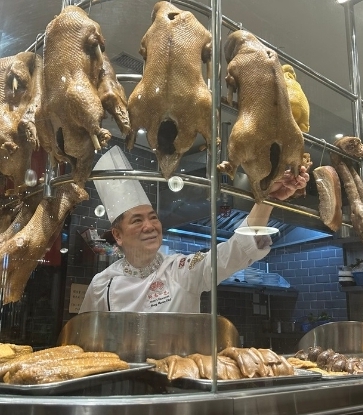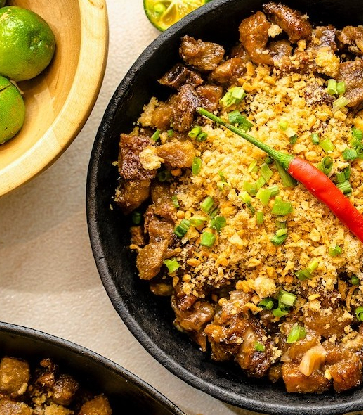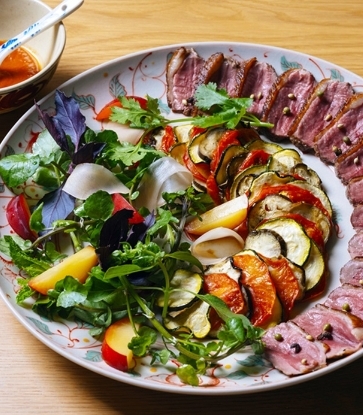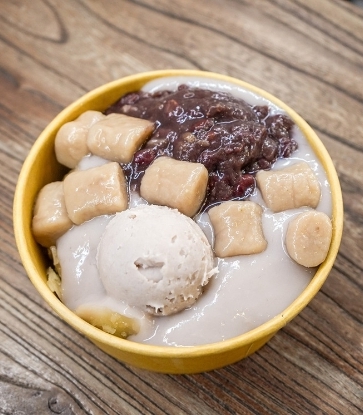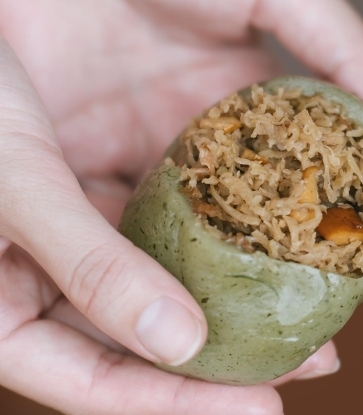Tai Wai Dining Room is located not far from Tai Wai MTR station. Before the new East Rail Line cross-harbour extension came into operation, a visit to Tai Wai Dining Room was something you had to go out of your way for, but now it’s an easy 30-minute trip from Central to Tai Wai. Opened four years ago, this “neighbourhood canteen” has been awarded the Bib Gourmand label by MICHELIN Guide Hong Kong Macau 2022—a recognition of this small local eatery’s hard work. “The whole team was ecstatic by MICHELIN’s recognition. Our phones wouldn’t stop ringing on the day the award was announced.” As it’s been very busy, co-owner Keith says they’ve yet to celebrate. “To be frank, we didn’t really celebrate because we wanted to keep our original intention of offering high-quality, delicious food at a reasonable price to local diners. We’ll continue what we do whether or not we have the MICHELIN title,” Keith says humbly.
Over at the barbecued meats section, the very experienced chef On lights up at the mention of Cantonese barbecue. Take the restaurant’s signature No. 1 Char Siu as an example. “The char siu must be made with premium pork collar butt and number one shoulder butt. Marinating the meat with hoi sin sauce, ground bean sauce, sesame sauce and garlic, then doing a second marination with licorice powder can really enhance the charcoal aroma after roasting.” Chef On is very enthusiastic in describing the process of making char siu: start off with high heat to reduce the juices, then switch to medium and then low heat. This gives the char siu a tender texture. Then add maltose and glaze the meat on high heat, which creates crunchy charcoal burnt edges that really take this dish to another level. Tai Wai Dining Room also offers an alternative way to savour barbecued pork: Ecstasy Char Siu. Once served, the char siu is first coated with flower honey with tangerine peel and red fermented bean curd. A blow torch is then used to add a sweet, smoky aroma to the dish. Another one of chef On’s iconic dishes is Pipa Goose. He says that low heat should be used for roasting goose, which gives an enticing aroma and a mouth-watering sheen to the crispy skin.


Also at the helm of the kitchen, the soft-spoken and humble chef On explains that the cooking methods of these dishes are similar, so it’s the ingredients that really make the difference. “Our restaurant uses fresh chicken. The dried squid used with the steamed meat patty is Kowloon dried squid— the most premium kind—which has been sun-dried to give an intense aroma,” says chef On. “We try to use local seasoning and condiments where possible, such as Liu Ma Kee’s fermented bean curd, Tai Ma Sauce’s soy sauce, and Yu Kwen Yick’s chilli sauce. We use the 70-year-old Kam Cheung Hoo’s Chinese sausage, which is only available in winter. We only serve what’s in season.” Chef On and the owners wish to pass on the art of Cantonese cuisine, so diners often see recreated classic dishes on the menu. An example is the braised wattle-necked softshell turtle carapace skirt, a lost art that is very arduous to prepare. The softshell turtle’s carapace skirt requires two days of soaking, and is then braised with chu hou paste, roast pork and shiitake mushrooms. Getting the heat right is crucial, or else the carapace skirt becomes too soft or too hard.
Apart from side dishes, Tai Wai Dining Room also offers dim sum. Available during lunch, their signature salted egg yolk custard bun is a must-have. Specialises in dim sum, chef Hung makes the dough and custard fresh every day. The custard is a blend of light cream and fresh milk, which lends a more natural, richer flavour. Only available in limited quantities and each one larger than a fist, the restaurant’s Chinese-style donuts (sa yong) are deep-fried at low temperature for over an hour, which require constant attention from the chef and true dedication in order to keep this common people’s snack alive. Another dish not to be missed is the soup dumpling (goon tong gao). Most soup dumplings nowadays sit in a bowl of soup, but the traditional way calls for all the broth to be inside the dumpling skin. The broth is simmered with ham and chicken for 18 hours, then fillings such as Hokkaido scallop, shiitake mushrooms, shrimp and conpoy are added for a burst of umami.
RELATED: Kung Wo Beancurd Factory: Soy Products to Take You Down Memory Lane

Keith and the other co-owners weren’t familiar with the F&B industry, but thanks to their experienced chefs and staff, Tai Wai Dining Room has made a name for itself. Store manager Ling and the manager, who was nicknamed Lo Yeh (“Master”), have been working at the restaurant since its opening. Perhaps it’s the enthusiasm and passion of the owners that really kept them there. “There are many Chinese-style restaurants backed by groups and Chinese fast-food eateries out there, but the quality is not what we want. So we decided to open our own Chinese restaurant and make delicious Chinese dishes.” Keith’s original intention of opening Tai Wai Dining Room was quite simple, and in the future, he hopes to take root in Tai Wai and continue to serve the local community.
CONTINUE READING: Chillies: A Spicy Origin Story
Photos and text by Gloria Chung (@foodandtravelhk), translated by Iris Wong. Read original article here.





